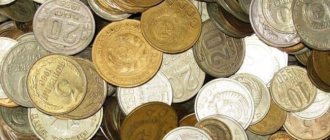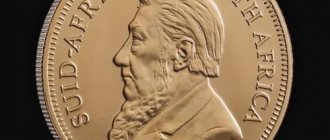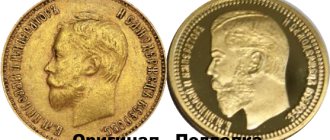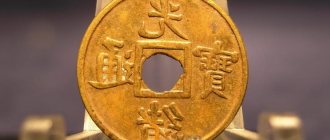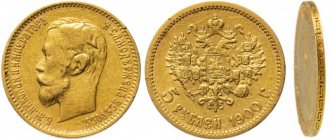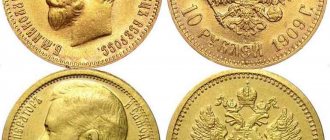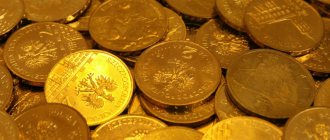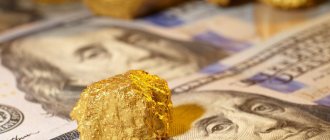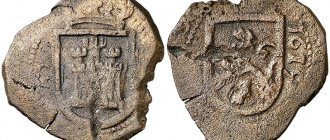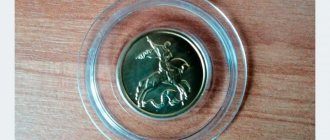Favorites(0
)
Please login to bookmark
USSR coins are all coins issued by the State Bank of the USSR from its creation in 1923 (as well as coins of the RSFSR 1921-1923) until the collapse of the Soviet Union in 1991. The Soviets also minted gold coins: both at their very beginning, in the 20s, for the sake of strengthening and stabilizing the currency of the new country of workers and peasants that arose instead of Tsarist Russia, and almost at sunset, in the 70s-80s - from ideological and practical considerations.
The Civil War (1917-1923), which led to the victory of the Bolsheviks and the establishment of Soviet power, as well as the subsequent policy of “war communism”, led to terrible hyperinflation. a card system in place since the First World War . Everyone wanted to eat, it was necessary to somehow change goods, and the country was literally swallowed up by the naturalization of economic relations. In parallel with this, tsarist money, “pyatakov”, “kerenki”, numerous surrogates and local issues circulated.
In order to take control of the financial and monetary system, the People's Commissariat of Finance of the RSFSR in 1919 decided to issue Soviet paper banknotes - Sovznaki .
The experiment was unsuccessful, they depreciated very quickly, and in 1921 the real value of 100,000 Sovznak was equal to one pre-revolutionary kopeck.
Already in 1922, a denomination was carried out, and the new Soviet sign of the 1922 model was equal to 10,000 old ones. All other parallel money was exchanged at the same rate, including royal rubles, kerenkas, etc.
In 1922, the authorities legalized the circulation and circulation of royal gold and silver. 10 gold royal rubles were equal to 12,500 Sovznak in 1922.
Sovznak did not even think about strengthening itself, so the Soviet government decided to create the State Bank again, return to the gold backing of money and begin issuing “chervontsi” in banknotes.
The authorities rightly believed that the population would positively perceive the traditional Russian name for gold ten-ruble coins. Paper chervonets (1, 3, 5, 10 and 25) were put into circulation in November 1922. And the people really accepted the new money with enthusiasm and trust, because they wrote on it: “1 chervonets contains 1 spool of 78.24 shares (7.74 g) of pure gold.”
The State Bank immediately set the exchange rate: 1 chervonets - 11,400 sovznak. For some time, the two monetary systems ran in parallel, but on March 25, 1924, the Council of People's Commissars of the USSR ordered to begin withdrawing sovznaki from circulation. For 1 new ruble (1/10 of a chervonets) they already gave 50,000 Soviet signs of the 1923 model. Since the summer of 1923, wages for workers and employees began to be paid in chervonets.
Chervonets (Sower) 1923
In October 1922, a decision was made to issue gold chervonets in the form of coins, and in June 1923, the Petrograd Mint (since 1924 - the Leningrad Mint) began minting gold coins - “chervonets” . The Soviet government had the metal for this, because the nationalization of banks in December 1917 was accompanied by the confiscation of the population’s funds, primarily gold and silver in coins and bullion.
Gold chervonets were not minted for the purpose of exchanging citizens for banknotes; their main task was to instill confidence in other countries in the monetary system of the Soviet state. For chervonets, the authorities purchased goods needed by the country on foreign markets.
Technically (8.6 grams of 900 gold, which is 7.74 grams or 1/4 troy ounce of chemically pure Au) and geometrically (diameter 22.6 mm, thickness 1.7 mm) the Soviet chervonets, minted as UNC, fully corresponded to the royal 10 ruble coin of 1897. Therefore, they were exchanged at the pre-war rate: 1 US dollar - 1.94 rubles.
The design of the Soviet coin was developed by the former leading artist and medalist of the St. Petersburg Mint, Anton Vasyutinsky (1858-1935). On November 27, 1922, the coin project was approved and minting began.
The obverse of the coin depicts the coat of arms of the RSFSR (approved in July 1918 by the Fifth All-Russian Congress of Soviets), the international slogan “Workers of all countries, unite!” and the inscription "R.S.F.R."
On the reverse was a peasant, based on a sculpture by Ivan Shadr (kept in the Tretyakov Gallery), sowing a field in the rays of the rising sun against the backdrop of smoking factory chimneys.
Because of this, the chervonets were called “Sowers” . To the left of the peasant is the year of minting - 1923, on the edge there is the inscription: “1 GOLD 78.24 PARTS OF PURE GOLD (P.L.).” On top there is an inscription “One chervonets” in a semicircle.
Golden chervonets of 1923 were issued in a circulation of 2,751,200 pieces.
In 1924, after the formation of the USSR, it was decided to issue new 1925 chervonets , where the coat of arms of the RSFSR would replace the coat of arms of the USSR. Other parameters were not changed.
It was planned to mint six million coins, but for reasons that will be stated, this plan remained on paper. Today, only test copies of “Sower-1925” have survived: one coin made of copper and five of gold, three of which are kept in the Gosznak Museum, and two in the State Museum of Fine Arts named after A. S. Pushkin.
The fact is that in 1925, the countries of Western Europe staged a “ golden blockade ” of the USSR and collectively refused to accept “Sowers” as a means of payment, allegedly because of Soviet symbols. The problem was solved in an unconventional way - the authorities ordered the surviving stamps to be used for minting royal gold coins. By March 1926, the Soviets had stamped 3,011,000 coins with the profile of Nicholas II: 2,011,000 with a face value of 10 rubles and 1,000,000 with a face value of 5 rubles.
Numismatists call them “ Italians ,” debate about their distinctive features, and speculate about which years the coins were minted. The prevailing opinion is that these are 10 rubles from 1911 (official circulation 50,011 pieces) and 5 rubles from 1898.
The “sowers,” rejected by the capitalists and imperialists, were melted down into gold bars, used for the production of dental crowns, etc. Later, their export outside the USSR was prohibited.
Since the end of the 20s, world powers began to massively abandon payments in gold coins, and since 1931, a course was taken and the transition to a floating exchange rate of national currencies, which in 1944 resulted in the Bretton Woods agreements.
Specified coins, including the gold chervonets, lost their role, and in 1931 the USSR last minted 10, 15 and 20 kopecks from silver. Then coins began to be made from copper and nickel alloy; since 1961, coins were switched to brass and nickel silver.
Sculpture by Ivan Shadr “The Sower”
What was the history of the creation of Shadr’s sculpture “The Sower”? The search for a suitable colorful nature led the master to the Urals, to the village of Prygovaya, Shadrinsky district, which once gave Ivan Ivanov the creative pseudonym “Shadr”. A lot of time passed before the sculptor was lucky enough to meet a strong man with a beard, Perfiliy Petrovich Kalganov, who agreed to pose for the bust of “The Sower.” Ivan Dmitrievich sculpted the waist part of a peasant with a basket from another peasant, Kiprian Kirillovich Avdeev.
Many specialist researchers highly appreciated the monumental sculpture of Shadr. “The Sower” is “a whole symbol of the entire sowing peasantry,” filled with spiritual strength, a hidden mind and an unbending will.
Nowadays, the most famous sculptures of Shadr are exhibited in the Tretyakov Gallery. Many of these works served as models for various artists to sketch for banknotes and postage stamps. And Ivan Shadr himself created sketches of not only Soviet banknotes, but also postage stamps for the 2nd Moscow Goznak factory. Wanting to make the figures with which he planned to decorate the money and stamps especially realistic, he worked long and hard on the images. At the same time, sculptural busts of a Red Army soldier, a peasant and a worker were first developed, and then the artist, choosing the best angle, made sketches. It was the image of the peasant that gained extraordinary popularity.
The drawing of the “Sower”, in addition to the golden chervonets, was placed on the three-chervonets banknote issued in 1924 and on the winning loan bonds of 1924, 1925, 1927.
Chervonets (Sower) 1975-1982
Gold coins were forgotten in the Soviet Union until 1975, when the State Bank of the USSR began stamping investment gold coins similar to the 1923 “Sowers” with the coat of arms of the RSFSR. They are sometimes called “remakes,” but this is incorrect, because these chervonets were not minted with the original stamps of 1923, but with new ones, where the current years were indicated - from 1975 to 1982.
Not only the appearance of the chervonets, but also other parameters remained unchanged: 900-carat gold, weight 8.6 grams (7.742 g of pure metal), diameter 22.6 mm, thickness 1.7 mm.
“Sowers” were minted as UNC at the Moscow and Leningrad Mints, which is displayed on the edge - “M.M.D. " or "L.M.D."
In 1975, 250,000 chervonets were issued. Their edge is decorated with the inscription: “1 GOLD 78.24 PARTS OF PURE GOLD.”
1976 - circulation 1,000,000 pieces (according to some sources 1,050,000). On the edge there is the same inscription - without indicating the mint - “1 GOLD 78.24 PARTS OF PURE GOLD.”.
1977 Some sources talk about 1,000,000 coins, Conros claims 2.015 million (1.165 million - MMD and 850 thousand - LMD). The inscription on the edge has changed - to the traditional “1 GOLD 78.24 PARTS OF PURE GOLD” they began to add “L.M.D.” or “M.M.D.”
1978 According to one source, the circulation was 1,000,000 pieces, according to Conros - 285-350 thousand. The edge indicates that the coinage was made in Moscow (M.M.D.).
1979 - 1,000,000 coins were issued. That year, chervonets were minted only in Moscow, as evidenced by the inscription “M.M.D.”
1980 - 1,000,000 units produced as UNC. Minting was carried out at MMD.
Also in 1980 , the Union issued 100,000 “Sowers” as a proof - polished coinage. Coins with a mirror surface were minted in both Moscow and Leningrad, for approximately 50,000 each.
1981 - 1,000,000 gold coins as UNC. Konros claims that almost the entire batch was made at MMD (787 thousand), but a rare Leningrad coinage (190 thousand) was also found.
1982 Open sources write about 1,000,000 coins as UNC, but a number of experts claim that the circulation is 10 times less. According to Konros, 50-60 thousand pieces were minted in Moscow; experts from the Staraya Moneta numismatic club talk about 65,000.
LMD produced even less - 28,000 coins.
If we assume that 1 million coins were minted annually (except 1975), it turns out that from 1975 to 1982 7,350,000 “Sowers” were produced. In particular, this figure is cited by Gosznak.
The Central Bank of the Russian Federation reports other data - 6,565,000 pieces , and employees of the Cash Circulation Department of the Bank of Russia V. Gerasimov and Yu. Pospelova write about 6,665,000. According to their data, the USSR Ministry of Finance allocated more than 51 tons from state funds for the production of chervonets gold, of which more than 40 tons of coins were sold on the markets of the USA and Western Europe.
There were no publications in the Soviet press about the release of gold chervonets. The press release of the State Bank of the USSR was published via TASS channels only in some publications abroad. The fact is that “Sowers” were conceived as expensive currency souvenirs for foreigners who attended the 1980 Olympics in Moscow. However, it was not possible to sell them then, so since the mid-90s the Central Bank of the Russian Federation has been trading them as investment coins. In practice, this meant that until 2000, buyers paid VAT of 20%. Transactions with bullion coins were exempt from the tax, but until 2011 it was levied on collectors who purchased commemorative coins. The Central Bank of the Russian Federation sold its stock of gold chervonets only in 2006.
Gold Coin Sower
The Golden Chervonets is one of the most expensive coins of the USSR. The main purpose of the Sower coin was payment for foreign trade transactions. Soviet chervonets did not become widespread among the population.
The Sower is one of the main investment coins in Russia, along with the following:
- gold coin St. George the Victorious;
- silver coins Sable and St. George the Victorious.
XXII Olympic Games in Moscow
In connection with the holding of the XXII Olympic Games in Moscow, from 1977 to 1980, 45 commemorative coins were issued in the USSR:
- 6 made of copper-nickel alloy with a denomination of 1 ruble;
- 14 made of 900-carat silver, weighing 16.67 grams and denomination 5 rubles;
- 14 coins made of 900-carat silver, weighing 33.3 grams and with a face value of 10 rubles;
- 6 coins made of 900-carat gold, weighing 17.28 grams (15.71 grams of pure gold - 1/2 troy ounce), with a face value of 100 rubles;
- 5 coins made of 999-carat platinum, weighing 15.54 grams, with a face value of 150 rubles.
The author of the Olympic coin projects is Viktor Ermakov.
The implementation of the Olympic coin program was carried out by Vneshtorgbank of the USSR, which later became Vnesheconombank of the USSR. On the territory of the Soviet Union, Olympic coins made of precious metals were sold only in “foreign exchange” stores. Only foreigners could buy them and only for freely convertible currency.
Soviet citizens were prohibited from both having currency and conducting transactions with currency values, which included coins made of silver, gold or platinum. Numismatists had to be content with collecting a meager collection of rubles from a copper-nickel alloy, or take risks and invent schemes for purchasing coins from precious metals.
How to determine the cost yourself
Since 2001, chervonets began to be accepted in branches of Russian banks at an unstable rate, changing every day. On average, their cost for 1975-1982 is 20,000 rubles. The “Sowers” of the Leningrad MD 1981 and 1982 sell much more expensively: the first one is quite realistic to sell for 135,000 rubles, the second for 75,000.
In order to understand that you have that same treasured gold piece in your hands, it is enough to take it to any pawnshop to confirm the composition of its alloy. The hunt for the originals of 1923 is still underway. It is known that among the coins bought by the bank there may be those very “Sowers”, but so far no one has been able to find a single copy among all the copies in the bank vaults.
"Historical" series
On September 13, 1988, the first issue of coins made of precious metals of the Historical Series “ 1000th anniversary of ancient Russian coinage, literature, architecture, baptism ” was released. Their reverses reflect the era of Kievan Rus of the 10th–11th centuries, depicted in architectural monuments, ancient Russian literature, and the first coins of Vladimir Svyatoslavovich.
Gold, silver, platinum and, for the first time, palladium were used to make coins in this series.
The coin of this series of 50 rubles from 1988 “St. Sophia Cathedral in Novgorod” was minted on the MMD with a circulation of 25,000 pieces as proof.
The coin is made of 900-carat gold, the weight of pure metal is 7.78 grams, the diameter is 22.6 mm.
100 rubles of 1988 “Zlatnik of Vladimir” were minted on MMD with a circulation of 14,000 pieces as proof.
The coin is made of 900-carat gold, the weight of pure metal is 15.55 grams, the diameter is 30 mm.
Subsequent issues of the Historical Series were dedicated to the eras of Ivan III, Alexander Nevsky, Dmitry Donskoy, Peter I, Catherine II, and other historical periods of Russia.
On August 31, 1989, the series “500th anniversary of the unified Russian state” , published until 1991. It included six commemorative gold coins.
coin of 1989 “Assumption Cathedral in Moscow” was minted on the MMD with a circulation of 25,000 pieces as proof.
The denomination coin is made of 900-carat gold, the weight of pure metal is 7.78 grams, the diameter is 22.6 mm.
100 rubles of 1989 “State Seal of Ivan III” were minted on the MMD with a circulation of 14,000 pieces as proof.
The coin is made of 900-carat gold, the weight of pure metal is 15.55 grams, the diameter is 30 mm.
coin of 1990 “Monument to Peter I in St. Petersburg” was minted on the MMD with a circulation of 14,000 pieces as proof.
The coin is made of 900-carat gold, the weight of pure metal is 15.55 grams, the diameter is 30 mm.
50 rubles 1990 “Church of the Archangel Gabriel in Moscow” were minted on MMD with a circulation of 25,000 pieces as proof.
The coin is made of 900-carat gold, the weight of pure metal is 7.78 grams, the diameter is 22.6 mm.
100 rubles 1991 “L.N. Tolstoy (1828-1910) – Russian writer” were minted on MMD with a circulation of 14,000 pieces as proof.
The coin is made of 900-carat gold, the weight of pure metal is 15.55 grams, the diameter is 30 mm.
50 rubles 1991 “St. Isaac’s Cathedral in St. Petersburg” - minted on MMD with a circulation of 25,000 pieces as proof.
The coin is made of 900-carat gold, the weight of pure metal is 7.78 grams, the diameter is 22.6 mm.
It was planned to sell 10% of the Historical Series circulation in the USSR for rubles. For gold coins with a face value of 50 rubles, the price was set at 710 rubles.
Famous marriages
Among the coins of 1980 and 1981, there was a whole batch of fakes. Their distinctive features were the rotation of the obverse relative to the reverse by 45 or 90 degrees, and the arable land made with wide relief strokes. The roof of the factory was not parallel to the horizon, and the letter “a” in the word “gold” on the edge was capitalized. The weight also differed, both up and down. It is quite possible to sell such coins, and the surprising thing is that they are willing to pay several thousand more for counterfeits. However, such sales are not welcomed by many auctions and forums, so the coins will have to be sold, as copies should be, “illegally.”
Among the serious defects you can see on the hands of collectors are worn or scratched coins, with a poorly printed design or worn out during use.
"Russian ballet"
In 1989, a series of commemorative coins “Russian Ballet” was launched, which enjoyed enormous popularity abroad. On October 1, 1991, seven gold coins from this series were released.
Three gold coins from the Russian Ballet series
100 rubles 1991 “Russian Ballet” as proof. Minted on LMD in an edition of 1,500 pieces from 999-carat gold, weight 15.55 grams, diameter 30 mm.
100 rubles 1991 "Russian Ballet" as UNC with a denomination of 100 rubles. Minted on LMD in an edition of 1,200 pieces from 585-carat gold, pure metal weight - 15.55 grams, diameter 35 mm.
50 rubles 1991 “Russian Ballet” as proof. Minted on LMD in an edition of 1,500 pieces from 999-carat gold, weight - 7.78 grams, diameter 22.6 mm.
50 rubles 1991 “Russian Ballet” as UNC. Minted on LMD in an edition of 2,400 pieces from 585-carat gold, pure metal weight - 7.78 grams, diameter 28.6 mm.
25 rubles 1991 “Russian Ballet” as proof. Minted on LMD in an edition of 1,500 pieces from 999-carat gold, weight - 3.11 grams, diameter 16 mm.
25 rubles 1991 “Russian Ballet” as UNC. Minted on LMD in an edition of 5,000 pieces from 585-carat gold, pure metal weight - 3.11 grams, diameter 21 mm.
10 rubles 1991 "Russian Ballet" as UNC with a denomination of 10 rubles. Minted on LMD in an edition of 8,000 pieces from 585-carat gold, pure metal weight - 1.555 grams, diameter 17 mm.
The sower today
The remaining coins from those circulations are still sold today in branches of the Bank of Russia. Their quotes change every day, so the gold sower is not a means of payment. Due to the lack of denomination in rubles and the constantly changing value, they are called “investment coins,” that is, a means for investing money. It is in them that citizens and collectors invest free currency. Over the years, chervonets have become steadily more expensive. Their current price is from 17 to 25 thousand rubles and more. Special issue money goes from various auctions even for 45 thousand rubles.
Nowadays, the golden chervonets sower from 1923 is very expensive. The numismatic value averages 150 thousand rubles. At auction, a superb quality gold sower coin can fetch around $7,500. Money of satisfactory quality is valued at approximately $2,000.
Important! The total number of coins issued at all times, including the golden chervonets sower of 1923, amounted to more than ten million copies; 50 tons of precious metal were spent on production.
What does the novel “The Twelve Chairs,” which became a kind of monument to the USSR in the 1920s, tell us about the chervonets? A noteworthy scene was when Ostap Bender pretended to be an artist on a ship that was conducting circulation of government bonds. The son of Lieutenant Schmidt is tasked with drawing a propaganda poster depicting a sower scattering government bonds instead of seeds. Father Fyodor also pays archivist Korobeinikov in tens: “Nine and a half is today’s exchange rate.” The characters inform the modern reader about the exchange rate of the gold piece in those days.
